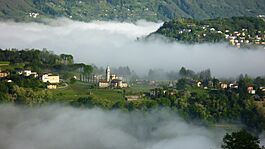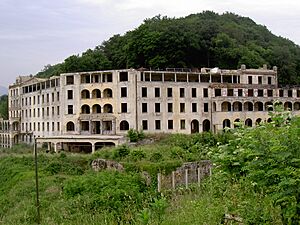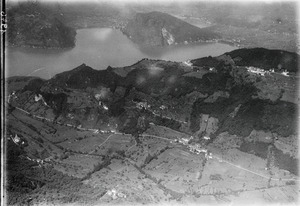Collina d'Oro facts for kids
Quick facts for kids
Collina d'Oro
|
||
|---|---|---|
 |
||
|
||
| Country | Switzerland | |
| Canton | Ticino | |
| District | Lugano | |
| Area | ||
| • Total | 6.15 km2 (2.37 sq mi) | |
| Elevation | 469 m (1,539 ft) | |
| Population
(Dec 2020 )
|
||
| • Total | 4,604 | |
| • Density | 748.6/km2 (1,938.9/sq mi) | |
| Postal code |
6926
|
|
| Localities | Agra, Carabietta, Gentilino, Montagnola | |
| Surrounded by | Agno, Grancia, Lugano, Magliaso, Muzzano, Sorengo | |
Collina d'Oro means "Golden Hill" in English. It's a town in the Ticino area of Switzerland, located in the Lugano district. This town was created in 2004 when the villages of Agra, Gentilino, and Montagnola joined together. Later, in 2012, the village of Carabietta also became part of Collina d'Oro.
Contents
History of Collina d'Oro
The villages that make up Collina d'Oro have a long history. Gentilino was first mentioned in records way back in 1210, and Montagnola in 1226.
Agra's Story
The small village of Bigogno, which is part of Agra, was first mentioned in 1270. Early records show that the church of S. Tommaso in Agra existed for a long time. It became its own small church area in 1591.
Long ago, people in Agra mostly farmed. But the village was also known for training skilled workers, like builders, who traveled to Russia and other parts of Europe. In 1912, a special health center called a sanatorium opened here. Many famous thinkers and writers stayed there. It closed in 1969 and is now in ruins.
Gentilino's Story
In the Early Middle Ages, Gentilino was part of a royal area given to the church leaders of Como in 818. Later, in the 11th century, it belonged to a monastery. The Church of S. Abbondio is very old, first mentioned in 1140. It was made bigger in the 17th century and looks like that today.
For many years, people in Gentilino were farmers. Many builders from here also traveled to other countries for work. Today, it's a place where people live and travel to work in the nearby city of Lugano.
Montagnola's Story
Montagnola, along with its smaller villages, became part of a larger community in 1535. Records from a monastery mentioned that there was once a fortress in Arasio, one of Montagnola's hamlets.
The churches of S. Silvestro and SS Nazaro were mentioned in records from 1270 and 1442.
Like other villages, Montagnola's economy was based on farming. Many architects and builders from families like Gilardi and Camuzzi became famous for their work in other European countries, especially Russia. The nice weather and beautiful location attracted many famous people, including the writer Hermann Hesse. There's a museum dedicated to him that opened in 1997. Since 1956, Montagnola has also been home to an international school, The American School In Switzerland. Because it's close to Lugano, many people who work in the city now live in Montagnola.
Carabietta's Story
Carabietta was first mentioned in 1335. It was a very small town.
In the past, Carabietta was special because it was exempt from taxes. This was confirmed by the Swiss Confederation in 1664 and 1784. The church of San Bernardo was built in 1634 on the site of an even older church.
People in Carabietta also farmed, and many relied on money sent home by family members who had moved away for work. Today, it has become a small town where people live and travel to work in other places.
Geography
Collina d'Oro covers an area of about 6.49 square kilometers (2.5 square miles). A little over 11% of this land is used for farming, and more than half (51.5%) is covered by forests. About 36% of the land has buildings or roads.
Part of Lago di Muzzano (Muzzano Lake) is shared with nearby towns.
Agra is located on a hill about 570 meters (1,870 feet) high. Gentilino covers the northern part of the Collina d'Oro valley. Montagnola stretches across the central part of the valley and includes several smaller villages. Carabietta is located on the arm of Lake Lugano that goes towards Agno.
Population and People
Collina d'Oro has a population of about 4,500 people. As of 2008, about 28.5% of the people living here were from other countries. The population has grown quite a bit over the last 10 years.
Most people in Collina d'Oro speak Italian (about 75%). The next most common language is German (about 10.6%), followed by English (5%).
In 2008, there were slightly more women (52.1%) than men (47.9%) living in Collina d'Oro.
The age groups in Collina d'Oro (as of 2009) show that about 9.6% of the population are children under 10, and 15.9% are teenagers between 10 and 19. Adults between 20 and 59 make up a large part of the population, and about 24% are seniors over 60.
Historic Population
This chart shows how the population of Agra, Gentilino, and Montagnola changed over time before they joined to form Collina d'Oro. The last bar shows the total population of Collina d'Oro in 2002.

Education
Many adults in Collina d'Oro (about 81%) have finished high school or gone on to higher education like university.
In 2009, there were 751 students in Collina d'Oro.
- There were 126 children in kindergarten.
- 334 students attended regular primary schools, and 5 attended a special primary school.
- In middle school, 143 students were in a two-year program, and 90 were in a four-year program to prepare for higher education.
- Some students also attended vocational schools, which prepare them for specific jobs.
Schools in Collina d'Oro
The main primary school is in Montagnola. There are also pre-primary (kindergarten) schools in both Montagnola and Gentilino.
The American School In Switzerland, an international school, is also located in Montagnola.
Public Library
The public library, called La Biblioteca comunale di Collina d'Oro, is in Montagnola, near the community school. It opened in 1990.
Economy
In 2007, the unemployment rate in Collina d'Oro was 2.58%.
- In 2005, about 31 people worked in the primary sector, which includes farming.
- 703 people worked in the secondary sector, which includes manufacturing and construction.
- 1,016 people worked in the tertiary sector, which includes services like shops, hotels, and offices.
Most people (65.6%) used a private car to get to work, while 8% used public transportation.
In 2009, Collina d'Oro had 4 hotels with a total of 40 rooms for visitors.
Important Heritage Sites
Some buildings in Collina d'Oro are considered very important national heritage sites in Switzerland. These include the Camuzzi House, the cemetery, and the Parish Church of S. Abbondio, which has an ossuary (a place for bones) and a Via Crucis (a series of images showing Jesus's last journey).
Famous Residents
The famous writer and Nobel Prize winner Hermann Hesse lived in Montagnola for over thirty years until he passed away in 1962. He is buried in the San Abbondio cemetery in Gentilino.
Housing
As of 2000, there were 1,545 homes in Collina d'Oro, with about 2.3 people living in each home on average. In 2008, very few homes were empty (only 0.45%). In 2007, new homes were being built at a rate of 3.6 new homes for every 1000 residents.
Transport and Sport
The northern part of Collina d'Oro has a train station called Cappella-Agnuzzo. Trains run frequently, making it easy to travel. The town also has bus services provided by Autopostale.
For sports, Collina d'Oro has two main facilities: Centro Ricreativo and Campo Campari, both in Gentilino. The official football team of Collina d'Oro plays at Campo Campari.
See also
 In Spanish: Collina d'Oro para niños
In Spanish: Collina d'Oro para niños











